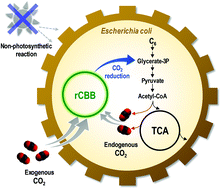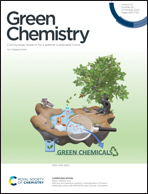Non-photosynthetic CO2 bio-mitigation by Escherichia coli harbouring CBB genes†
Abstract
To alleviate carbon dioxide (CO2) emission, alternative approaches have been considered, such as employing microorganisms capable of CO2-fixation using their own metabolic pathways. In this study, we introduced a synthetic CO2-fixation pathway into the industrial platform microorganism Escherichia coli to achieve immediate CO2 mitigation with a non-photosynthetic reaction. Specifically, the whole gene clusters (cbbI and cbbII operons) involved in the Calvin–Benson–Bassham (CBB) pathway in Rhodobacter sphaeroides (rCBB) were expressed heterogeneously in E. coli under a restrictive carbon source and dark conditions. The resulting strain with the whole rCBB was able to exhibit a higher level of endogenous CO2 recycling compared to the control strain. In addition, the electron requirements from the cathode and redox cofactors were increased following the activation of the CO2-fixation pathway without light irradiation. Exogenous CO2 from yeast fermentation was also mitigated through a simple gas-phase connection with the E. coli/rCBB culture system. This bacterial CO2 mitigation strategy has great potential to alleviate greenhouse gas emissions through biological processes to produce carbon neutral biofuels and value-added chemicals.



 Please wait while we load your content...
Please wait while we load your content...